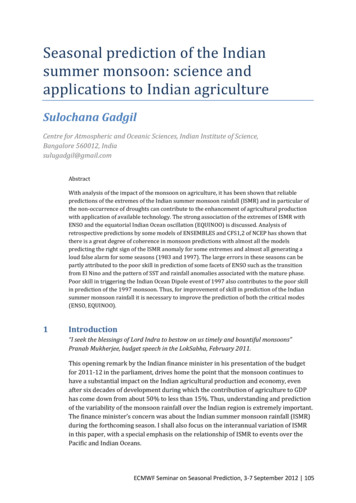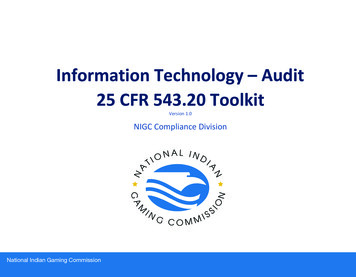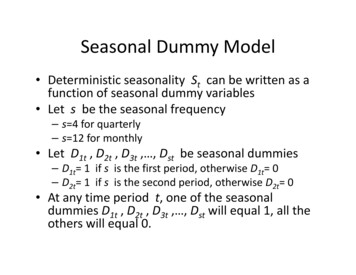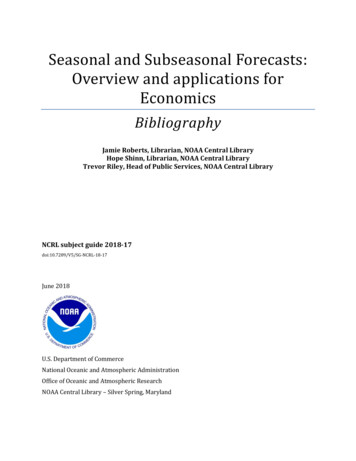
Transcription
Seasonal prediction of the Indiansummer monsoon: science andapplications to Indian agricultureSulochana GadgilCentre for Atmospheric and Oceanic Sciences, Indian Institute of Science,Bangalore 560012, Indiasulugadgil@gmail.comAbstractWith analysis of the impact of the monsoon on agriculture, it has been shown that reliablepredictions of the extremes of the Indian summer monsoon rainfall (ISMR) and in particular ofthe non-occurrence of droughts can contribute to the enhancement of agricultural productionwith application of available technology. The strong association of the extremes of ISMR withENSO and the equatorial Indian Ocean oscillation (EQUINOO) is discussed. Analysis ofretrospective predictions by some models of ENSEMBLES and CFS1,2 of NCEP has shown thatthere is a great degree of coherence in monsoon predictions with almost all the modelspredicting the right sign of the ISMR anomaly for some extremes and almost all generating aloud false alarm for some seasons (1983 and 1997). The large errors in these seasons can bepartly attributed to the poor skill in prediction of some facets of ENSO such as the transitionfrom El Nino and the pattern of SST and rainfall anomalies associated with the mature phase.Poor skill in triggering the Indian Ocean Dipole event of 1997 also contributes to the poor skillin prediction of the 1997 monsoon. Thus, for improvement of skill in prediction of the Indiansummer monsoon rainfall it is necessary to improve the prediction of both the critical modes(ENSO, EQUINOO).1Introduction“I seek the blessings of Lord Indra to bestow on us timely and bountiful monsoons”Pranab Mukherjee, budget speech in the LokSabha, February 2011.This opening remark by the Indian finance minister in his presentation of the budgetfor 2011-12 in the parliament, drives home the point that the monsoon continues tohave a substantial impact on the Indian agricultural production and economy, evenafter six decades of development during which the contribution of agriculture to GDPhas come down from about 50% to less than 15%. Thus, understanding and predictionof the variability of the monsoon rainfall over the Indian region is extremely important.The finance minister’s concern was about the Indian summer monsoon rainfall (ISMR)during the forthcoming season. I shall also focus on the interannual variation of ISMRin this paper, with a special emphasis on the relationship of ISMR to events over thePacific and Indian Oceans.ECMWF Seminar on Seasonal Prediction, 3-7 September 2012 105
S. Gadgil: Seasonal prediction of the Indian summer monsoonIt has been known for a long time that the Indian monsoon has an enormous impact onthe agriculture and economy, with India’s economy being described as a gamble on themonsoon rains in the colonial era. A quantitative assessment of the impact is nowavailable [Gadgil and Gadgil, 2006]. In this paper, after a brief discussion of the natureof the interannual variation of the ISMR, I elucidate the nature of the impact of themonsoon on the food grain production (FGP) in the country and the Gross DomesticProduct (GDP), suggest an explanation for the observed nonlinear relationship of theimpact to ISMR and show that seasonal predictions for the occurrence and nonoccurrence of droughts, i.e. large deficits of ISMR, would be most useful for enhancingagricultural production in the face of the variability of the monsoon.I consider next, the present understanding of the interannual variation of the Indiansummer monsoon. A major advance in this occurred in the 80's with the discovery (orrediscovery) of a strong link with El Nino and Southern Oscillation, ENSO [Sikka, 1980;Pant and Parthasarathy, 1981; Rasmusson and Carpenter, 1983]. Recent studies[Gadgil et al., 2003, 2004; Ihara et al., 2007] have revealed that one more mode, viz. theEquatorial Indian Ocean Oscillation (EQUINOO), plays an important role in theinterannual variation of ISMR. Gadgil et al., (2004) have shown that all the extremes ofISMR can be understood in terms of the favourable/unfavourable phases of these twomodes. EQUINOO has been considered to be the atmospheric component of the IndianOcean Dipole/zonal (IOD) mode (Saji. et al. 1999, Webster et al. 1999). However, thecoupling between EQUINOO and the ocean component is weaker than that between theatmosphere and ocean components of ENSO. The study of Ihara et al.(2007) on therelationship of the variation of the monsoon with ENSO, EQUINOO and IOD, using datafor a much longer period (from 1881 to 1998) than that used by Gadgil et al (2004),also suggests that the variation of ISMR is better described by use of indices of ENSO aswell as EQUINOO (but not of ENSO and IOD).If it is possible to predict ENSO andEQUINOO for the forthcoming monsoon season, it will be possible to generate areliable one-sided prediction i.e. non- occurrence of one of the extremes (i.e. eitherdroughts or excess rainfall season).The challenging problem of the simulation and prediction of ISMR with atmosphericand coupled models is discussed in the light of our understanding of theteleconnections of the interannual variation of the monsoon. Despite the strong link ofthe Indian /Asian monsoon with ENSO, AGCMs forced by the observed sea surfacetemperature (SST) under AMIP (Gates 1992), as well as a CLIVAR Monsoon Panelintercomparison project for 1997-98, showed poor skill in the simulation of itsinterannual variation (Sperber and Palmer 1996, Gadgil and Sajani 1998, Kang et al2002, Wang et al.2004). Wang et al (2005) suggested that atmospheric models areinherently incapable of simulating the variability of the monsoon, even when they areforced by the observed SST, because of the special SST-rainfall relationship (asassessed by the correlation between the rainfall and local SST) over the warm oceanicregions such as South China Sea and tropical West Pacific. They concluded that there isa ‘Fundamental challenge in simulation and prediction of summer monsoon rainfall’which calls for a reshaping of current strategies for monsoon seasonal prediction. Iftheir hypothesis is true, coupled models as a class would have a higher skill than106 ECMWF Seminar on Seasonal Prediction, 3-7 September 2012
S. Gadgil: Seasonal prediction of the Indian summer monsoonAGCMs, in simulating the SST-rainfall relationship and hence the interannual variationof the monsoon.It is, therefore important to elucidate the nature of the observed relationship betweenrainfall and local SST of tropical oceans and assess the skill of AGCMs and CGCMs insimulating it. The observed relationship of organized deep convection/high rainfallover tropical oceans to the local SST, is highly nonlinear, with a high propensity fordeep convection/high rainfall for SST above a threshold of about 27.50C and a largespread in the convection/precipitation values for each SST for SSTs above thethreshold (Gadgil et al 1984, Graham and Barnett 1987, Waliser and Graham 1993,Zhang 1993, Bony et al 1997, Rajendran et al 2012). For such a nonlinear relationship,correlation is not an appropriate measure (Graham and Barnett 1987). It has beenshown that the correlation coefficient depends upon the range of SST and for SSTsabove the threshold, the correlation between convection/rainfall and local SSTbecomes insignificant (Gadgil et al. 1984). In a recent study by Rajendran et al. (2012),the runs of the atmospheric and the coupled versions of nine global climate modelsused in the Fourth Assessment Report of the Intergovernmental Panel on ClimateChange (IPCC AR4) were analysed. They have shown that the SST–rainfall relationshipsimulated by the AGCMs and CGCMs in IPCC AR4 is nonlinear, as observed, andrealistic over the tropical West Pacific and the Indian Ocean as well as the Nino3.4region. Furthermore, the SST–rainfall pattern simulated by the coupled versions ofthese models is found to be rather similar to that from the corresponding atmosphericone, except for a shift of the entire pattern to colder/warmer SSTs when there is acold/warm bias in the coupled version. Thus it appears that poor skill of simulationand interannual variation of the monsoon by AGCMs cannot be attributed to their skillin simulating the SST-rainfall relationship over warm parts of the tropical Indian andPacific Oceans and improvement of the atmospheric component of the models cancontribute towards better simulation and prediction of the variability of the monsoon.Finally, I discuss the skill of the state-of art coupled models in predicting ISMR, and inparticular, the extremes. Recent studies have shown that there has been considerableimprovement in the skill of retrospective predictions of ISMR with coupled models.While the correlation of the multi-model ensemble (MME) prediction with theobserved ISMR for the models in DEMETER (Palmer et al.2004) was 0.22 (Preethi et al2010) the correlation for the MME from six models of ENSEMBLES(http://www.ecmwf.int/research/EU projects/ENSEMBLES/) is 0.45 (Rajeevan et al.2012). However, despite considerable improvement over the last decade, none of themodels at the global centres were able to predict the droughts of 2002, 2004 and 2009.Hence further improvement is essential.A surprising result from the analysis of the predictions of the extremes by the sixmodels of ENSEMBLES and the two versions CFS1 and CFS2 of the NCEP model is thecoherence in the prediction of most of the extremes ISMR, despite the differencesbetween the models. Thus the extremes for which almost all the models predict thecorrect sign of the ISMR anomalies include the seasons with strong ENSO signal such as1987, 88 as well as those with a strong positive phase of EQUINOO associated with theIOD events such as 1961 and 1994. This coherence is seen the bad predictions as well.Almost all the models predict deficit ISMR for the excess monsoon season of 1983, andECMWF Seminar on Seasonal Prediction, 3-7 September 2012 107
S. Gadgil: Seasonal prediction of the Indian summer monsoon2large deficit for the monsoon season of 1997 with a positive ISMR anomaly. Asexpected, inadequate skill in prediction of the SST of the equatorial Indian Ocean andconvection over that ocean contributes to the poor skill in prediction of for theseseasons. However, it turns out that the large errors in the prediction of ISMR can beattributed also to the error in prediction of the timing of the transition from El Nino(e.g. 1983) and the strength and spatial patterns of anomalies characterizing themature phase of El Nino (e.g. 1997). Thus improvement in prediction of some facets ofENSO as well as of triggering of positive IOD events is required for improvement of theskill of the models in monsoon prediction.Interannual variation of the Indian summer monsoon rainfallMost of the rainfall over the Indian region as a whole occurs during the summermonsoon season of June-September. The large-scale summer monsoon rainfall isassociated with a continental tropical convergence zone in the monsoon zone north ofabout 180N over the subcontinent. The value of ISMR, for any year, is a weightedaverage of the June-September rainfall at 306 well-distributed rainguage stationsacross India [Parthasarathy et al., 1992, 1995 and the web site of Indian Institute ofTropical Meteorology (http://www.tropmet.res.in/)]. In fact, ISMR is a very reliablefacet of our atmosphere with the range of the interannual variation from 1870onwards being 70% to 120% of the long term mean of about 85cms and the standarddeviation, about 10% of the mean. The variation of ISMR from 1960 is shown inFigure 1. Seasons with the magnitude of the ISMR anomaly larger than one standarddeviation (i.e. of normalized anomaly larger than 1) are extremes -droughts/ excessrainfall seasons for negative/positive anomaly. It is seen that droughts occurred veryfrequently during 1965-87 and after a lull during 1988-2001, the frequency has beenhigh in the last decade with droughts in 2002, 2004 and 2009).Figure 1: Variation of the anomaly of the Indian summer monsoon rainfall (ISMR), normalized bythe standard deviation, during 1960-20113Impact of the monsoon on agriculture and GDPThe Indian food-grain production (FGP), and the GDP, have increased rapidly sinceindependence (Figure 2a).It is seen that the FGP has grown exponentially at 2.7%during 1950-94, but slowed down since then to 1.2% , perhaps because of the fatigueof the green revolution (Gadgil and Gadgil 2006). The GDP grew at the ‘Hindu rate of108 ECMWF Seminar on Seasonal Prediction, 3-7 September 2012
S. Gadgil: Seasonal prediction of the Indian summer monsoongrowth’ of 3.6% until 1980; grew more rapidly at 5.3% over the next two decades andeven faster in the last decade (Figure 2b).Over and above these long term trends, thereare year to year fluctuations which can be attributed to important events in the yearand particularly the monsoon. The impact of the monsoon is taken as the differencebetween the observed value of FGP/GDP in a year and the value it would have if it grewaccording to the long term trend.Figure 2: a Variation of the Indian foodgrain production (FGP) during 1950-2009.b Variation of the Indian Gross Domestic product (GDP) during 1950-2009c Impact of the monsoon on the FGP versus ISMR anomalyd Impact of the monsoon on the GDP versus ISMR anomalyThe variation of the impact on FGP (IFGP), and on GDP (IGDP) with ISMR anomaly isshown in Figure 2c and d respectively. It is seen that the impact is highly nonlinear forFGP and GDP, with the negative impact of negative ISMR anomaly being much largerthan the positive impact of an ISMR anomaly of the same magnitude. Furthermore,since 1980, while the negative impact of a deficit monsoon on FGP has remained aslarge as in during 1951-1980, the positive impact of a positive anomaly has decreasedsubstantially (Table1). Over the last three decades, there have been major changes inthe cropping patterns, due to various factors including larger impact of the marketeconomy, availability of high yielding varieties etc. and the traditional complexcropping system is now replaced by mono-cropping over large tracts of land. This hasled to a large number of pests and diseases becoming endemic. Furthermore, intensivefarming has resulted in loss of fertility of the soil. In this situation, application offertilizers and pesticides has become necessary for getting high yields. A comparison ofECMWF Seminar on Seasonal Prediction, 3-7 September 2012 109
S. Gadgil: Seasonal prediction of the Indian summer monsoonthe observed yield for rain-fed (i.e. non-irrigated) crops at farmers’ fields and with thaton agricultural stations in the same regions (Figure 3, after Sivakumar et al 1983),suggests the reason for the asymmetry in response to rainfall variability. When therainfall is low, both yields are low but when the rainfall is high, the yield at theagricultural stations is much higher than that of the farmers’ fields. The majormanagement differences between the farmers’ fields and the agricultural stations arefertilizer and pesticide applications. In rain-fed agriculture, such applications enhanceyield substantially (and hence are cost-effective) only when there is sufficient rainfall.Farmers generally do not invest in fertilizers and pesticides over rain-fed regionsbecause it is not economically viable in years of poor rainfall (Gadgil et al 2003), andreliable predictions of the non-occurrence of such a drought are not available. Hencethe farmers do not get enhancement of yields commensurate with the rainfall in goodrainfall years. It is clear that a reliable forecast for average or above average rainfall(i.e., for no drought ) can help in increasing the overall surpluses in FGP. Clearly,prediction of the occurrence and non- occurrence of extremes of ISMR should be animportant focus of seasonal prediction.Table 1: Expected impact of the monsoon on FGP during 1951-1980 and 1981-2004PeriodISMR-25-20-15-10-5051015201951 - 87.211981 3-0.79Figure 3: Variation of the grain yield at farmers’ fields and agricultural stations (for the samecrop/variety in the same agro-climatic regime) under rain-fed conditions, versus seasonal rainfall(after Sivakumar et al.(1983)110 ECMWF Seminar on Seasonal Prediction, 3-7 September 2012
S. Gadgil: Seasonal prediction of the Indian summer monsoon4Interannual variation of the Indian summer monsoon: presentunderstandingThe correlation between ISMR and the OLR over the Indo-Pacific region for thesummer monsoon (June-September) is shown in Figure 4. It is seen that there is a largenegative correlation between the ISMR and convection/rainfall over the central Pacific.This is a manifestation of the link between the Indian summer monsoon and El Ninoand Southern Oscillation [ENSO]. ISMR is also highly correlated withconvection/rainfall over the western equatorial Indian Ocean and negativelycorrelated with the convection/rainfall over the eastern equatorial Indian Ocean. Thisis a manifestation of the link of ISMR with EQUINOO.Figure 4: Correlation of ISMR with OLR at every grid point over 30E-70W and 40S-40NThe strong link between the ISMR and ENSO is manifested as an increased propensityof droughts during El Nino and of excess rainfall during La Nina (Sikka, 1980, Pant andParthasarathy 1981, and Rasmusson and Carpenter 1983 etc.). To depict therelationship of the ISMR with ENSO, we use an ENSO index based on the SST anomalyof the Nino 3.4 region (120 -170 W, 5 S-5 N), since the magnitude of the correlationcoefficient of ISMR with the convection over the central Pacific is higher than that withconvection over the east Pacific (Figure 5). The ENSO index is defined as the negativeof the Nino 3.4 SST anomaly (normalized by the standard deviation), so that positivevalues of the ENSO index imply a phase of ENSO favourable for the monsoon. El Ninoevents are associated with ENSO index less than -1.0 and La Nina with ENSO indexgreater than 1.0.The relationship of ISMR with ENSO index is shown for the period 1958-2004 inFigure 5, in which the droughts and excess rainfall seasons of ISMR can also bedistinguished. It is seen that ISMR is well correlated with the ENSO index with acorrelation coefficient of 0.54 which is significant at 99%. When the ENSO index isfavourable ( 0.6), there are no droughts and when it is unfavourable ( -0.8) there areno excess monsoon seasons. However, for intermediate values of the ENSO index, thereare several droughts and excess rainfall seasons. If we consider the interannualvariation of the monsoon since 1980, consistent with the links of the monsoon withENSO, the El Ninos of 1982 and 1987were associated with droughts and the La Nina of1988with excess rainfall (Figure 4). It turned out that for 14 consecutive yearsECMWF Seminar on Seasonal Prediction, 3-7 September 2012 111
S. Gadgil: Seasonal prediction of the Indian summer monsoonbeginning with 1988, there were no droughts; furthermore, during the strongest ElNino event of the century in 1997, the ISMR was higher than the long-term mean(Figure 1) and Krishna Kumar et al.(1999) suggested that the relationship between theIndian monsoon and ENSO had weakened in the recent decades. Then came thedrought of 2002, which occurred in association with a much weaker El Nino than thatof 1997 and neither the statistical nor the dynamical models could predict it. Theintriguing monsoon seasons of 1997 and 2002 triggered studies which suggested a linkto events over the equatorial Indian Ocean (Gadgil et al. 2003, 2004).Figure 5: Variation of ISMR with ENSO index (defined in the text)The major difference between the OLR anomaly patterns for July 1997 (for which theall-India rainfall was close to the normal) and 2002 (for which the all-India rainfall wasdeficit by a massive 49%) is found to be over the equatorial Indian Ocean (Fig. 6a).Whereas in July 1997, the convection is enhanced over the western equatorial IndianOcean and suppressed over the eastern equatorial Indian Ocean, the reverse is the casefor July 2002.Suppression of convection over the eastern equatorial Indian Ocean (90 -110 E, 10 S-EQ, henceforth EEIO) tends to be associated with enhancement over thewestern equatorial Indian Ocean (50 -70 E, 10 S-10 N, henceforth WEIO) and viceversa. EQUINOO is the oscillation of a state with enhanced convection over WEIO andreduced convection over EEIO (positive phase) and another with anomalies of theopposite signs (negative phase). The positive phase of EQUINOO (e.g. Fig. 6b) isassociated with easterly anomalies in the equatorial zonal wind; whereas the negativephase (i.e. with enhanced (suppressed) convection over the EEIO (WEIO)), isassociated with westerly anomalies of the zonal wind at the equator. It is seen fromFigure 6a that while the phase of ENSO in 1997 is the same as that in 2002, the phaseof EQUINOO is positive in 1997 and negative in 2002. That a positive phase ofEQUINOO with enhanced convection over WEIO is favourable for the monsoon isclearly seen from the pattern of the correlation of ISMR with OLR (Figure 4). It shouldbe noted that the magnitude of the correlation of ISMR with the convection over WEIOis comparable to that with the convection over the central Pacific corresponding to thelink with ENSO. We use an index of the EQUINOO based on the anomaly of the zonalcomponent of the surface wind over the central equatorial region (CEIO, 60 E-90 E,112 ECMWF Seminar on Seasonal Prediction, 3-7 September 2012
S. Gadgil: Seasonal prediction of the Indian summer monsoon2.5 S-2.5 N), which is highly correlated (coefficient 0.79) with the difference betweenOLR of WEIO and EEIO. The zonal wind index (henceforth EQWIN) is taken as thenegative of the anomaly so that positive values of EQWIN are favourable for themonsoon.Figure 6a: OLR anomaly patterns for July 2002 (top) and July 1997 (bottom),Figure 6b: Anomaly patterns of SST (left), OLR and surface wind (right) for June –September 1994(top)and 1997(bottom)ECMWF Seminar on Seasonal Prediction, 3-7 September 2012 113
S. Gadgil: Seasonal prediction of the Indian summer monsoonFigure 7: Extremes of ISMR (red for droughts and blue for excess rainfall seasons) in the phaseplane of EQWIN and ENSO index.In Figure7, the ISMR for all the seasons, i.e. the June–September seasons in the period1958–2004, is shown in the phase plane of the June to September averages of the ENSOindex and EQWIN. The most striking feature of the distribution of extreme years is theclear separation between the years with excess and deficits with each of the surplus(deficit) years located above (below) a certain line in the phase plane of the twoindices (the line L in Figure 7). This distribution in the phase plane suggests that anappropriate index would be a composite index, which is a linear combination of theENSO index and EQWIN. When the value of this index is high (i.e. point above the lineL) not only is there no chance of droughts but also no chance of moderate deficits. Forlow values of the index (i.e. below the line L), there is no chance of excess rainfallseasons but a small chance of moderate excess rainfall (Gadgil et al 2004).5Note that during the strong El Nino of 1997, a strong positive phase of EQUINOOoccurred, and as a result of this tug of war, the monsoon rainfall was close to normal.While for the excess monsoon season of 1988, both the modes were favourable, that of1994 was associated with a favourable EQUINOO and an unfavourable ENSO. I discusssimulation/prediction of ISMR for these special cases in the next two sections.Why is the skill in simulation/prediction of the interannualvariation of ISMR by AGCMs poor?Analysis of AMIP (Gates, 1992) results for 1979-93 showed that, even when AGCMs areforced by the observed SST, their skill of the in simulating the interannual variability ofthe Asian/Indian summer monsoon rainfall is poor (Sperber and Palmer 1996; Gadgiland Sajani 1998 etc.). Wang et al (2004) analyzed ensemble simulations of Asian–Australian monsoon (A–AM) anomalies in 11 AGCMs for the unprecedented El Ninoperiod of September 1996–August 1998. They showed that (i) the simulations ofanomalous Indian/Asian summer rainfall patterns were considerably poorer than in114 ECMWF Seminar on Seasonal Prediction, 3-7 September 2012
S. Gadgil: Seasonal prediction of the Indian summer monsoonthe El Nino region and (ii) the skill in the ensemble simulations with the SNU model for1950-98 of the Indian monsoon is significantly higher than the skill for the period1996–98. They concluded that ‘During 1997/98 El Nino, the models experiencedunusual difficulty in reproducing correct Indian summer monsoon anomalies’.Wang et al (2004) suggested that the cause of the models’ deficiencies is the failure tosimulate correctly the relationship between the summer rainfall and the local SST overthe Philippine Sea, the South China Sea, and the Bay of Bengal. This led to a paper on‘Fundamental challenge in simulation and prediction of summer monsoon rainfall’ byWang et al (2005) that has received a lot of attention. They examined the simulationskill of five state-of-the-art AGCMs, forced by identical observed SST and sea-ice, inseasonal precipitation for a 20-year period of 1979–1998. They pointed out that thecorrelations of the observed local SST and precipitation anomalies are negative overthe West north Pacific and insignificant over the Bay of Bengal and that the SST-rainfallcorrelations in the MME simulation disagree with observations primarily in the AsianPacific monsoon regions. They attributed the unsuccessful simulations of the rainfallvariability in the Asian-Pacific summer monsoon under AMIP-type experimentaldesign to the neglect of air-sea interaction in the warm Indo-Pacific oceans, andsuggest that the coupled atmosphere-ocean processes are extremely important in theheavily precipitating monsoon regions. On the other hand, Gadgil et al. (2005)attributed the poor skill of AGCMs to ) a poor skill in simulation of the monsoonEQUINOO link.In order to identify the strategy for improvement of the models, it is important tounderstand why the skill of the models is poor whether either of the hypothesesproposed are valid. We note that, if the Wang et al (2005) hypothesis is valid, thecoupled models as a class would have higher skill than the AGCMs, in simulation SSTrainfall relationships over the warm Indo-Pacific oceans and hence also of thevariability of the Indian/Asian monsoon. Thus it is important to assess the skill insimulation of the SST-rainfall relationship by AGCMs and CGCMs.Consider first the nature of the observed relationship between convection/rainfall andlocal SST. The observed SST-rainfall relationship is highly nonlinear (Gadgil et al 1984,Graham and Barnett 1987, Waliser et al. 1993; Zhang 1993; Bony et al. 97; Lau and Sui97etc.) It has been shown that, (i) there is a threshold of SST around 27.50C with a highpropensity for organized convection /high rainfall over oceans with SST above thethreshold. (ii) When the SST is above the threshold, the OLR/rainfall varies over a largerange from almost no convection/rainfall to high rainfall/intense deep convection foreach SST. The correlation coefficient between the local SST and the convection/rainfalldepends on the range of SST (Gadgil et al . 1984). When SST varies over a large rangeacross the threshold, the correlation is significantly positive (as for the Indian Ocean:60 -100 E, 15 S-20 N ). However, for oceanic regions with SST maintained above thethreshold (such as the Bay of Bengal, tropical West Pacific etc.) the correlation isinsignificant (Gadgil et al 1984). Clearly, for such a nonlinear relationship, correlationis not an appropriate measure (Graham and Barnett 1987). However, in the Wang et al(2004,5) studies, simulation of the SST-rainfall relationship was assessed by acomparison of the observed and simulated correlation between the rainfall and localSST.ECMWF Seminar on Seasonal Prediction, 3-7 September 2012 115
S. Gadgil: Seasonal prediction of the Indian summer monsoonAn important question that arises is: ‘How good are the simulations of tropical SST–rainfall relationship by atmospheric and coupled models?’ Rajendran et al. (2012)addressed this question, by analysis of the runs of atmospheric and coupled versions ofnine IPCC AR4 climate models, for the present day climate. The observed relationshipFigure 8a For the Indian Ocean (IO: 60-100 E;15 S-20 N),Left:Observations of the relationship between rainfall and SST for June, July, August during 19792009: Scatter plot with the number of points for each 0.25 C SST and 0.5mm rainfall bin is shownabove and the variation with SST of the 90% percentile of rainfall (blue curve), mean rainfall(black curve), and the standard deviation of rainfall (red curve) shown below. ;Right: Scatter plots for simulation by AGCM and CGCM (above) and variation with SST of the 90%percentile and the mean rainfall (below) for the GFDL, CNRM and IPSL models.Figure 8b For WPO (120-140 E;10-20 N)Left: Observations of the relationship between rainfall and SST for June, July, August during 19792009: Scatter plot with the number of points for each 0.25 C SST and 0.5mm rainfall bin is shownabove and the percentage of occurrence of the number of grids for each SST interval (below)Right: Scatter plots for simulation by AGCM and CGCM for GFDL and CNRM models116 ECMWF Seminar on Seasonal Prediction, 3-7 September 2012
S. Gadgil: Seasonal prediction of the Indian summer monsoonbetween rainfall and SST over the Indian Ocean (IO: 60 -100 E, 15 S-20 N ) tropicalWest Pacific (WPO:120 -140 E, 10 -20 N) is shown in Fig. 8a and b respectively. Thefrequency distribution of the observed SST for WPO is also shown in Fig. 8b. It is seenthat overWPO, which is always maintained above the threshold, there is an enormousspread of rainfall values for each value
summer monsoon: science and applications to Indian agriculture Sulochana Gadgil Centre for Atmospheric and Oceanic Sciences, Indian Institute of Science, Bangalore 560012, India sulugadgil@gmail.com . Abstract . With analysis of the impact of the monsoon on agriculture, it has been shown that reliable










